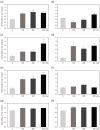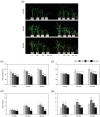Effects of Acute and Chronic Gamma Irradiation on the Cell Biology and Physiology of Rice Plants
- PMID: 33669039
- PMCID: PMC7996542
- DOI: 10.3390/plants10030439
Effects of Acute and Chronic Gamma Irradiation on the Cell Biology and Physiology of Rice Plants
Abstract
The response to gamma irradiation varies among plant species and is affected by the total irradiation dose and dose rate. In this study, we examined the immediate and ensuing responses to acute and chronic gamma irradiation in rice (Oryza sativa L.). Rice plants at the tillering stage were exposed to gamma rays for 8 h (acute irradiation) or 10 days (chronic irradiation), with a total irradiation dose of 100, 200, or 300 Gy. Plants exposed to gamma irradiation were then analyzed for DNA damage, oxidative stress indicators including free radical content and lipid peroxidation, radical scavenging, and antioxidant activity. The results showed that all stress indices increased immediately after exposure to both acute and chronic irradiation in a dose-dependent manner, and acute irradiation had a greater effect on plants than chronic irradiation. The photosynthetic efficiency and growth of plants measured at 10, 20, and 30 days post-irradiation decreased in irradiated plants, i.e., these two parameters were more severely affected by acute irradiation than by chronic irradiation. In contrast, acutely irradiated plants produced seeds with dramatically decreased fertility rate, and chronically irradiated plants failed to produce fertile seeds, i.e., reproduction was more severely affected by chronic irradiation than by acute irradiation. Overall, our findings suggest that acute gamma irradiation causes instantaneous and greater damage to plant physiology, whereas chronic gamma irradiation causes long-term damage, leading to reproductive failure.
Keywords: DNA damage; acute and chronic irradiation; antioxidant activity; growth and reproduction; oxidative stress; photosynthetic efficiency.
Conflict of interest statement
The authors declare no conflict of interest.
Figures








References
-
- Rutherford L. Origin of the gamma rays*. Nature. 1932;129:457–458. doi: 10.1038/129457a0. - DOI
-
- Gerward L. Paul Villard and his discovery of gamma rays. Phys. Perspect. 1999;1:367–383. doi: 10.1007/s000160050028. - DOI
-
- Mba C., Shu Q.Y. Gamma irradiation. In: Shu Q.Y., Forster B.P., Nakagawa H., editors. Plant Mutation Breeding and Biotechnology. CABI; Oxfordshire, UK: 2012. pp. 91–98.
Grants and funding
LinkOut - more resources
Full Text Sources
Other Literature Sources

